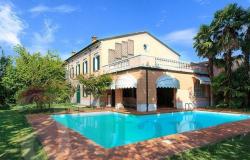 Leonardo da Vinci, considered one of the greatest geniuses ever, had moments of insecurity about his intellectual ability, a new exhibit reveals. A bundle of Leonardo's designs, sketches, notes and ideas on display in Milan's Sforza Castle includes evidence of his painstaking efforts to improve his language skills.
Leonardo da Vinci, considered one of the greatest geniuses ever, had moments of insecurity about his intellectual ability, a new exhibit reveals. A bundle of Leonardo's designs, sketches, notes and ideas on display in Milan's Sforza Castle includes evidence of his painstaking efforts to improve his language skills.
The so-called Codex Trivulzianus contains a list of some 8,000 words from common spoken Italian, which experts believe he compiled in an effort to improve his ability to express himself.
Trained in a Florentine workshop, Leonardo received no classical education in either Latin or Greek - a gap in his knowledge that he found problematic when he arrived at the sophisticated Milanese Court of the Sforzas in 1482. Leonardo also had little grasp of formal, written Italian, a "new language" that was just starting to replace the widely varying dialects spoken across the territory previously.
A fresh analysis of the list - penned, as was Leonardo's custom, in mirror writing - has led experts to conclude that it was his way of trying to keep up with the more urbane literary talents he encountered at the court. By examining his choice of words, they have managed to work out several of the texts that he studied as part of his efforts to improve his grasp of the language.
The most notable of these appears to be a treatise by Roberto Valturio on military arts, from Roman times until the Renaissance. Although written in Latin between 1446 and 1455, Leonardo's notes reveal he worked with a translation into
common Italian.
As well as helping Leonardo polish up his linguistic skills, his study of the text formed part of a broader fascination with military projects, which played a key role during his work at the court. The Codex Trivulzianus contains a variety of sketches of fortifications and armour-clad prows, as well as information on diverse subjects such as the best way to shoe horses, put nails in soldiers' boots and how to retain one's balance on a ship-deck made slippery by an attacking enemy.
The exhibition of the Codex Trivulzianus, normally accessible only to scholars, has been timed to coincide with the fifth centenary of Leonardo's return to Milan. Although originally from Tuscany, Leonardo spent a great deal of his life in Milan, residing there from 1482 to 1499 and again from 1506 until 1513.
The precious manuscript, usually stored in the private Trivulziana Library in the Sforza Castle, last went on public display in 1998.
It comprises a folder, containing 55 sheets, each measuring 20.5 x 14 cm.
The contents amount to a kind of personal notebook in which Leonardo jotted down ideas, designs, thoughts and sketches, touching on a variety of subjects. Most of the pages date from between 1487 and 1490, when Leonardo was working under the patronage of Duke Ludovico Sforza.
The manuscript is on show for two months, with different sheets on display each day. As well as the Leonardo codex, the exhibit will showcase a number of other 15th and 16th-century texts and illuminated manuscripts.
The Milan city council has planned a variety of additional initiatives linked to the exhibit, including conferences and talks. A series of panels on Leonardo's talent and his ties to Milan under the Sforzas will be set up along the two roads leading up to the castle, the Via Mercanti and the Via Dante.
"Leonardo da Vinci is also a Milanese icon," said Milan's culture councillor, Stefano Zecchi. "I hope this event will lay the foundations for a larger project linked to his genius," he added, explaining plans to try and capitalize on Leonardo's reputation abroad.
Ludovico Sforza, Leonardo's patron for 17 years, gave him free rein to work on any project he chose during this first period in Milan, when the codex was completed. As well as designing court festivals, he developed a variety of engineering sketches and produced a string of drawings, sculptures, and paintings - including The Last Supper, which played a pivotal role in Dan Brown's
bestselling blockbuster The Da Vinci Code.
He left Milan in 1499 after the city fell to the French.
In later years he travelled around Italy and France, although he returned to Milan for five years, where he was sponsored by Charles d'Amboise.
The Codex Trivulzianus can be visited in the Sforza Castle's Sala delle Asse until May 21.



